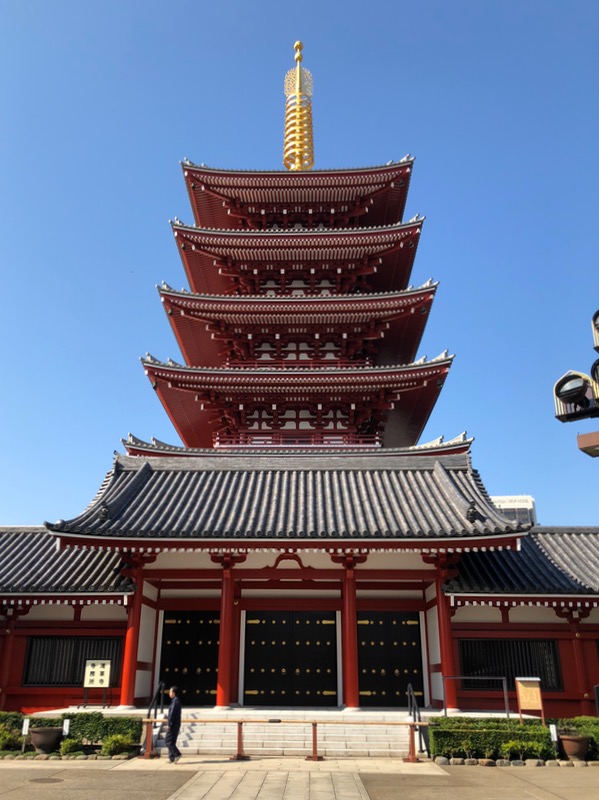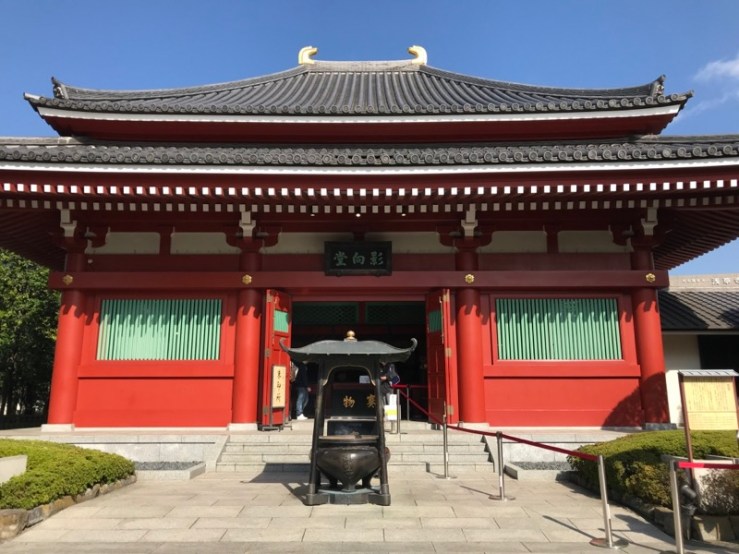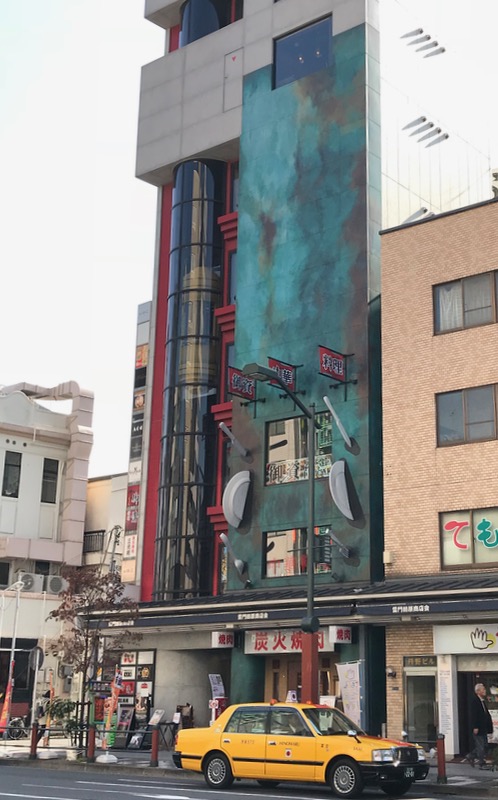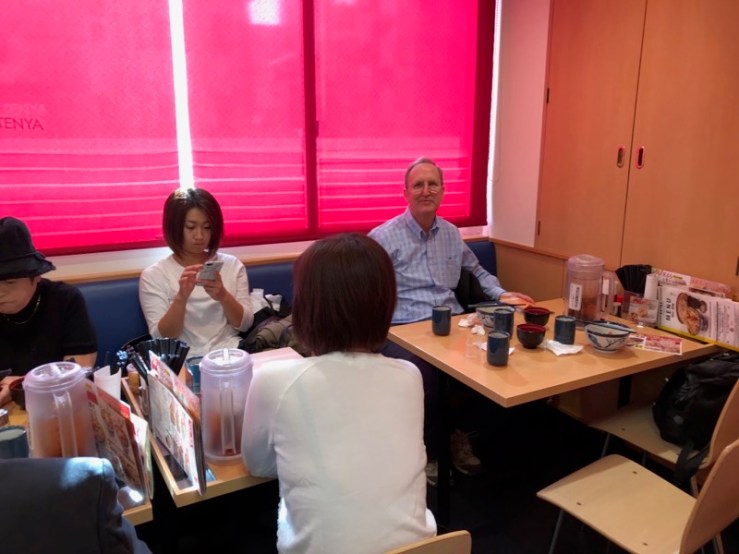This is post #2 of our Tokyo-Seoul trip, for the first half of Monday, November 6, 2017.

Coming out of our hotel room after a typical first-night-in-a-new-country sleep, we see this. I guess we can tell where the elevators are.

Our hotel is in the Ginza area of Tokyo, near to where Dave’s conference will be, and before we leave the hotel’s wifi, out of habit, we check where we are going for breakfast. Later on in the trip, we wouldn’t do this, as we would become used to the fact that we had a wifi hotspot in our backpack.


As newbies in town, everything was fascinating and intriguing — the Nissan building with the car in the front window, the Mitsukoshi Department Store clock, and the pyramid of seasonal chestnut treats:


More on this later as nothing was open yet, and we were headed to City Bakery, then to Asakusa Temple.

This is the first time we saw a scramble intersection: where everyone could walk every which way at once.


City Bakery didn’t disappoint this Monday morning. So much to choose from. We tried using our Google Translate app on this item, a “Baker’s Muffin” in order to see what was inside. It pulled up something like “flour, egg, and breath of angels.” Hmmm. We found that idioms didn’t translate well into English, and sometimes were completely off-track.

This was also available. Beautiful, but no.

Since we’d been to Japan before in 2001, we knew the drill: get the tray, use the tongs to put the food on the tray. At the checkout, we buy juice to go with our breakfast, and pick up plastic ware for the road, and silverware for in-restaurant use. We sit down at the only vacant table, apparently vacant because all the regulars in this coffee shop know that the ventilation system blows gale force right where we sit. We anchor all the napkins under our baked goods, and enjoy our meal, saving a few bites for later.

City Bakery was in the basement of a building, and this was the area next to it. Later on, we’d learn that we could take a train from here and get places, but we are early in the trip, so re-trace our steps upstairs to get to our train, passing by the “love-inviting” stone cat, which people stroke for luck.


We used our Pasmo cards, and (hopefully) get to the correct track, correct train. The Hyperdia app was invaluable during our stay here:


I used my Snapseed app to label critical photos in my feed, like what our home station was near our hotel. Now it seems silly, but then it was a lifeline.

Another thing I did habitually was to photograph the exit from the subway at a particular destination so I could find it again, like this time, when it dumped us into a small non-descript alleyway.

I wondered when I would see my first display of wax food in Tokyo. This is actually pretty convenient for non-Japanese-speaking tourists, as it provides the opportunity to see what the restaurant served, and the chance to point at it, if you can’t make yourself understood to the waitress.


Oh, yes, I always have egg on my spaghetti.

We made it to the Sensoji Temple in Asakusa, founded in 628. It has a main temple and a five-story pagoda. We pause in the main gate area, underneath the Kaminarimon Gate — or “Thunder Gate” — with its huge red chochin lantern.

“Its chronicles put its founding at 628 AD through one of these stories that legends and religions are made of: While fishing in the Sumida River on the morning of March 18, the brothers Hinokuma Hamanari and Takenari caught in their nets a small golden statue of the Buddhist deity Kannon. They tried to get rid of it, but it kept coming up so they decided to keep it. When they returned to the village, they showed it to one of the chieftains Haji no Nakatomo who being a devout Buddhist understood what it was and built a temple to house it. The temple was, of course, Sensoji. ‘Senso’ is another reading of the characters for Asakusa and ‘ji’ is ‘temple’.” (from here)

From the main gate, there is a walk up Nakamise Dori, the shopping street, full of small shops. We are early, so some are not open, but I loved the sprays of (faux) fall foliage jutting out from the roofs.


Overview of the area.

Hozomon, the Sensoji Temple’s actual main gate.



Not Geisha. I found out later that kimono are available to rent, and many young women will rent them and tour the temples, taking their photos as they go.

A group of school children, with matching red hats, with the five-storied pagoda in the background.

I made Dave do this with me, under great protest: drawing an omikuji. I had an English-speaking Japanese tourist help me, as I couldn’t quite remember the drill.
We both drew bad fortune, so instead of being to bring the paper home, we had to tie it to a rack. Judging by how many pieces of paper are tied at all these temples, I wonder if the temple puts out more bad fortune papers in those drawers, than good.



Now that we’ve donated money to the temple, we go to explore more of the area, in spite of the crush of tourists.


Private-school students, with matching uniforms.

Around us the incense is blowing around, the smokey air playing havoc with breathing (and even though we are supposed to draw the smoke over an aching body part, we side step it and head into the temple


And then we go out again. No photos are allowed and a service was going on in the inner sanctum, so not much to see. We appreciated the gorgeous decorations; I buy an omamori charm: a small bell.

Looking out from the doors of the temple toward the Hozomon Gate.





We read the guidebook, appreciate the pristine gardens and the beautiful five-storied pagoda, available for entry only at certain times in the year, and only if you have family buried here.

Our first Japanese vending machine of the trip.

Mine must have had caffeine in it, because it kept me going the whole day.


We head into another building, and buy an accordian-folded book, so the monk (or his assistants behind him) will write their shrine’s name in calligraphy and then place the shrine’s stamp in it, in glorious vermillion ink. This costs 300 yen, or 500 yen sometimes — about $4.50 US dollars. The shuincho is notebook, and the shu-in is a stamp with calligraphy.




We got a Christmas Card photo shot–one of several we’d take. Such beautiful doors!

They have tree-trimming down to a art.

She’s holding her selfie-stick to one side of the photo. We see them strike this pose repeatedly for tourists.



We wander over to the Asakusa shrine, another ancient place (but apparently not reconstructed like everything we see — WWII bombs didn’t destroy this one), and get another signature in my new accordian book.
Outside a family is posing for pictures. Was it Children’s Day? as both the little boy and the little girls are dressed up in traditional dress. Dave thought maybe it was that they presented the them to the priests at a certain age. It’s Shichi-Go-San.
“In the custom, which literally means “seven-five-three,” families with three- or seven-year-old girls or five-year-old boys visit a shrine or temple to pray for the health of their offspring as they grow. Shichi-Go-San is traditionally observed on November 15, although with the busy pace of modern life it has become common for families to schedule visits to shrines on a weekend or holiday before or after the date.” (from here)

Dave steps up and offers to take the family’s photo. All smiles, all around. Dave later told me he thought tourists ought to be good for something!


We leave the shrine and wander down a street perpendicular to the Temple and see a lot of little shops in a decorative arcade.



We are headed to the the “kitchen street,” Kappabashi, but notice all the decorative surfaces as we walk.





We’re here, but what is it? It’s basically a street filled with little shops of things we don’t need: knives, steamers, pots. We amble and amble. Our first big disappointment in Tokyo Touristing: overly-hyped attractions, supposed “gems” found in my research at home on the internet, but in real life? Not so much.

Random Gold Statue that I made Dave pose in front of. I later found out that this is the Kappa Kawataro Statue, where Kappabashi gets its name. On a tourist website, I read:
“A kappa (“river child”) is a creature of Japanese myth: a humanoid, frog-like amphibious creature with a plate-like head, scales, webbed feet and beak for a mouth. However, although pronounced the same, the “kappa” in Kappabashi and the mythical “kappa” are written differently. The association is coincidental, but Kappabashi has nevertheless eagerly latched on to the kappa as a mascot. The street’s kappa statue is a gold-plated bronze statue erected here in 2003 for Kappabashi’s 90th anniversary.”

But it is interesting to see these decorated buildings: I wonder if the one with plates and silverware is related to the fact that we are in the Kappabashi area? Tired of trying to make sense of this area, we turn back toward the Metro.


But first, lunch! Love the take-out window in the front right, but we go inside and head upstairs. In our guidebook we read that Tendon is a combination of bowl (don) with tempura (ten).


They scurry to bring us the English menus. We are happy to know we’ll be eating non-stressed-out prawns.

We point to the special and it turns out to be very good, although eating the squid was a bit strange. The tempura was squash, green beans, white fish, prawn, lotus root over rice. It also came with a cup of miso soup.

Our table.

We figured out that we should take the bill downstairs and pay for it on the way out.

Design is all around us, as even the heavy metal grates that straddle the the sidewalk to the street are decorative.

We stop at a dish shop, buying four little plates, two bowls and two chopstick rests. It goes into the backpack along with everything else.

We laugh when we make our way back to the Metro and the shop right outside the entrance is a TENDON TENYA, where we had just eaten. They turn out to be all over the place.

Time for a break: We head back to the room for a rest.

Placard in the metro car.

Clearly we are below par with our shoe choice of American athletic shoes.
We arrive back at the hotel, and Dave immediately crashes into a deep sleep, but the caffeine in my early drink keeps me awake. I upload Instagram photos, watch the skyline from our our room, pondering what they are doing on the roof of the building just beside us. This mystery will be solved by the end of the week.


























I love the artistry of Japan. It is so distinctly NOT western. You’ve done a great job of capturing some of the details, and details seems to be what the Japanese excel in.